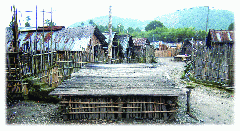Archives
festival
 The cycle of celebration continues as Hiichi group of villages such as Hija, Duta, Bamin-Michin, and Mudang-Tage take over the charge next year.
The cycle of celebration continues as Hiichi group of villages such as Hija, Duta, Bamin-Michin, and Mudang-Tage take over the charge next year.
Preparation begins from October just after harvesting ends in this beautiful valley. Villagers secretly ferret out to the jungle in search of a monkey, the skull and other organs of which are used to appease Siiki, the spirit that is invoked during the festival for social well-being. It is followed by reconstruction of Lapang, the open community wooden platform, used for meetings and rituals. Another important preparatory stage is erection of Babo, the decorated wooden pole of the community. Intricately decorated with woven festoons on a piece of wood at the top of the pole, Babo, symbolizing the importance of the male population in the villages, presents a majestic sight to viewers.
Collection of firewood, stocking of essential food items, preparation of ‘O’— the homemade rice beer—and renovation of Nago, the village altar for appeasing Siiki, follow as the festival draws near. In between, the priest performs various rituals by reading omens about the fate of sacrificial pigs.
When everything is set, the priest inaugurates Myoko in the evening at the Yugyang, the clan altar where  purification of pigs and fowls is performed. Attired in ceremonial dress, the priest also prays for the general welfare of the people as he performs the ritual called, Sama Pinnin. This is followed by Siiki Ninin ceremony where the priest appeases Siiki, the spirit that appears from the nether land to bless people. Pigyang Huniin, purification of pigs, Ajing Gyoniing, invitation to friends, other family and social rituals follow including community fishing, cultivation, and ceremonial work in jungle etc. until the priest conducts Empi Koniin in which fried rice is distributed to family members symbolizing the conclusion of the celebration.
purification of pigs and fowls is performed. Attired in ceremonial dress, the priest also prays for the general welfare of the people as he performs the ritual called, Sama Pinnin. This is followed by Siiki Ninin ceremony where the priest appeases Siiki, the spirit that appears from the nether land to bless people. Pigyang Huniin, purification of pigs, Ajing Gyoniing, invitation to friends, other family and social rituals follow including community fishing, cultivation, and ceremonial work in jungle etc. until the priest conducts Empi Koniin in which fried rice is distributed to family members symbolizing the conclusion of the celebration.
The most significant feature of this quintessential festival is involvement of every member of the society in one way or the other in the celebration process. It is as much for the married women as for the young and the old male members. Invitation to Buniin Ajin—the inherited friends who are bound by abiding ties of mutual help and familial alliance—and their hospitality for renewing the ties is another unique aspect in Myoko. ‘O’, local rice beer, meat and eggs are offered generously to relatives and neighbours and gifts of meat and ‘o’ are exchanged. Earlier, an acrobatic game called, Boha, was performed by skilled men on ropes strung high up between towering Babos erected in village yards.
The festival touches every aspect of the peoples’ life. If Dree, a fertility festival, is the harbinger of bumper crops and protection against epidemics, Myoko is the forerunner of riches and strength of the society, its social and inter-social unity and harmony. Its intrinsic values of peace and harmony, social welfare, and renewal of ties with both fellow human beings and gods are mostly intact even today even against winds of change in all aspects of life. It is the string that binds all beads of the Apatani community into a collective unit even as it shapes and defines their personality. Hage Tarung, a young and knowledgeable Apatani officer says, “Myoko festival covers all facets of the people and unites the entire society on a common platform.”
Hage must know, for almost all government officials and members of Hari and Tajang and Reru villages staying away from their villages also returned to participate in the celebration. Unlike other present ethnic festivals of the state, location of Myoko can not be shifted away from their root villages. There’s neither flag hoisting nor VIP encumbrance that are usually associated with most of the present-day festivals. Rooted deeply to the peoples’ soil and faith, Myoko will again be observed with devoutness in one of the host villages by the next spring.
Obang Tayeng

